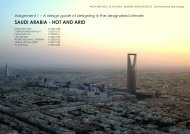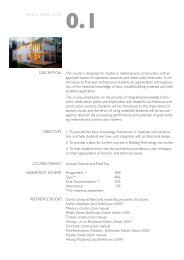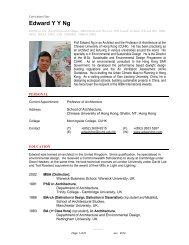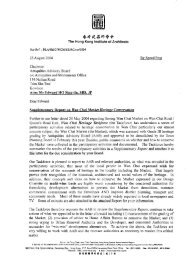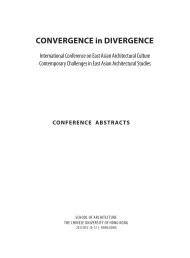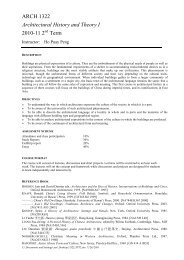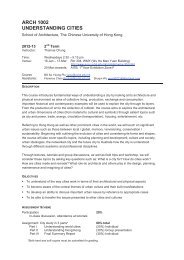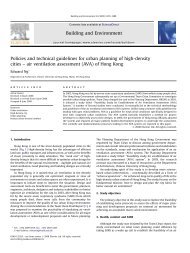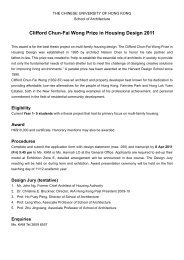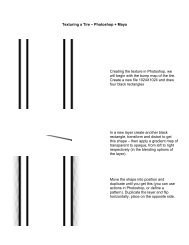Notebook IV - School of Architecture - The Chinese University of ...
Notebook IV - School of Architecture - The Chinese University of ...
Notebook IV - School of Architecture - The Chinese University of ...
Create successful ePaper yourself
Turn your PDF publications into a flip-book with our unique Google optimized e-Paper software.
ARCHITECTURE<br />
C U H K
architecture<br />
<strong>Notebook</strong> <strong>IV</strong><br />
2 This, the fourth notebook, describes the current<br />
standing <strong>of</strong> the programme: its form<br />
– intentions, premises, composition, and<br />
structure – as well as its content – teaching,<br />
research, and communication.<br />
3<br />
<strong>The</strong> form <strong>of</strong> the programme – its underlying<br />
structure <strong>of</strong> primary parts, their balance, and<br />
their relationships – has remained essentially<br />
constant since its inception. It has guided the<br />
balanced development <strong>of</strong> teaching as well as<br />
research, and has provided a framework for<br />
the establishment <strong>of</strong> the direction and strategic<br />
intentions and priorities.<br />
<strong>Architecture</strong> is a collective project. In a way it is like theatre, where much about the individual role is already<br />
defined by the play. This makes the role <strong>of</strong> the individual the more critical. In architecture the city is the play<br />
– and the stage. It is the world in the image <strong>of</strong> human beings in its past and its future in an eternal present. It<br />
is the context for the study <strong>of</strong> architecture as nature is the context for the study <strong>of</strong> natural science.
4 Programme 6<br />
5<br />
Curriculum 8<br />
Learning 10<br />
A school is not a building; it is a way <strong>of</strong><br />
thought. <strong>The</strong> place <strong>of</strong> study is not one<br />
particular building; it is the city and the<br />
world at large.<br />
contents<br />
Studios 12<br />
Habitation 14<br />
Urbanization 15<br />
Tectonics 16<br />
Technics 17<br />
Courses 18<br />
Design 20<br />
Humanities 22<br />
Technology 24<br />
Pr<strong>of</strong>essional practice 26<br />
Places <strong>of</strong> life 28<br />
<strong>The</strong> house and the city 32<br />
Student work 2003 – 2004 34<br />
Rooms 60<br />
Dates 62<br />
Teachers 64
programme<br />
6 7<br />
<strong>The</strong> programme deals with one subject:<br />
architecture. It is not merely a collection<br />
<strong>of</strong> courses; it is a projection <strong>of</strong> architecture<br />
onto an academic plane. It is not<br />
intended to cover or exhaust the subject;<br />
it provides one mode <strong>of</strong> access into it, like<br />
a map to a landscape.<br />
Degree programmes<br />
Pr<strong>of</strong>essional programme<br />
Postgraduate programmes<br />
BSSc(AS)<br />
Architectural studies<br />
MArch<br />
<strong>Architecture</strong><br />
PGDip<br />
Sustainable and environmental design<br />
MSc<br />
Sustainable and environmental design<br />
MPhil<br />
PhD
8 BSSc(AS) 1<br />
Introduction to architectural design I and II Introduction to architecture<br />
Introduction to building technology<br />
9<br />
BSSc(AS) 2<br />
BSSc(AS) 3<br />
Year out<br />
MArch 1<br />
MArch 2<br />
curriculum<br />
Design<br />
Graphics and visual studies<br />
Studios I and II:<br />
habitation, urbanization, tectonics, technics<br />
Computer-aided architectural design<br />
Studios III and <strong>IV</strong>:<br />
habitation, urbanization, tectonics, technics<br />
Electives<br />
Advanced studios I and II:<br />
habitation, urbanization, tectonics, technics<br />
Electives<br />
<strong>The</strong>sis project I and II:<br />
habitation, urbanization, tectonics, technics<br />
Humanities<br />
Architectural history and theory I<br />
Architectural history and theory II<br />
Architectural history and theory III<br />
Land and city<br />
Electives<br />
Urban design and planning<br />
Electives<br />
Architectural theory and criticism<br />
Technology<br />
Building technology I<br />
(materials and construction)<br />
Building technology II (building structure)<br />
Building technology III<br />
(environmental technology)<br />
Building systems integration<br />
Electives<br />
Advanced construction<br />
Advanced building services<br />
Electives<br />
Pr<strong>of</strong>essional practice<br />
Pr<strong>of</strong>essional practice<br />
Electives<br />
Pr<strong>of</strong>essional practice and management<br />
Electives
10 Teaching and learning are mutually complementary<br />
Research and discovery are both an attitude Teaching and research have two parts: content<br />
11<br />
and inseparable in practice, even in towards any study, and a specific activity. <strong>The</strong>y and operation. <strong>The</strong> operational aspect <strong>of</strong> both<br />
the specifically taught curriculum consisting are essential to the intellectual vitality <strong>of</strong> the is communication. All aspects <strong>of</strong> the department<br />
In architecture there is little to teach and<br />
such as academic or administrative as<br />
<strong>of</strong> design studios, courses, and independent Department. Research is conducted individually<br />
as well as in a group effort in research well its relationship with other bodies are<br />
studies.<br />
units.<br />
regarded as part <strong>of</strong> this operational idea.<br />
much to learn. <strong>The</strong> purpose <strong>of</strong> teaching<br />
is to prepare and inspire the process <strong>of</strong><br />
learning.<br />
learning<br />
Teaching<br />
Studios are organized so that students from all<br />
levels participate in them and have the opportunity<br />
to work together.<br />
Courses are <strong>of</strong>fered on specific subjects in<br />
humanities, technology, design, and pr<strong>of</strong>essional<br />
practice. <strong>The</strong>se are intended both to inform<br />
the work in the studios and to broaden the<br />
appreciation <strong>of</strong> the nature and structure <strong>of</strong><br />
knowledge in general.<br />
Independent studies are occasions available<br />
for exercise <strong>of</strong> initiative and skill in studying<br />
and cultivating habits <strong>of</strong> purposeful yet free<br />
exercise <strong>of</strong> the innate desire for discovery and<br />
design.<br />
Studios<br />
Courses<br />
Studies<br />
Research<br />
Design studios<br />
Architectural projects<br />
Architectural history<br />
Computation and simulation<br />
Community participation<br />
Environmental and sustainable<br />
design<br />
Communication<br />
Education is not about information. <strong>The</strong> basic<br />
instrument <strong>of</strong> communication in the department<br />
is the architecture department information<br />
system.<br />
It deals with all aspects <strong>of</strong> the programme,<br />
including administration, and provides for open<br />
access and exchange in one co-ordinated<br />
source.<br />
It contains all information related to the<br />
work and the operation <strong>of</strong> the department,<br />
course material, archival information, as well<br />
as department operational structure and<br />
guidelines.<br />
<strong>Notebook</strong><br />
Department information system<br />
cuhk architecture monographs
Studios are central to the culture <strong>of</strong> architectural<br />
education as public squares are<br />
to the culture <strong>of</strong> cities or laboratories to<br />
the culture <strong>of</strong> scientific education. <strong>The</strong>y<br />
host the chaos which allows free play <strong>of</strong><br />
ideas in search <strong>of</strong> ordered thought, design,<br />
and the exercise <strong>of</strong> imagination in the<br />
discovery and reconstruction <strong>of</strong> the field<br />
<strong>of</strong> architecture, and through it the development<br />
and formation <strong>of</strong> oneself in the<br />
process <strong>of</strong> education.<br />
studios<br />
Primary studios Studio projects <strong>School</strong> projects<br />
12 <strong>The</strong> studios are centered around study and Studio projects are occasions for study and <strong>School</strong> projects are formulated independently<br />
13<br />
research into the primal imperatives in the exercise based on the studio as “positions,”<br />
process <strong>of</strong> design and formation <strong>of</strong> architecture.<br />
not as dogma.<br />
Each term a studio project is followed by<br />
a school project.<br />
Habitation<br />
Urbanization<br />
Tectonics<br />
Technics<br />
<strong>The</strong> scope <strong>of</strong> the projects varies to suit the<br />
particular approach and pedagogical strategy<br />
<strong>of</strong> the studio. <strong>The</strong>y provide the possibility<br />
<strong>of</strong> exercises which are particularly suited to<br />
the issues in the studio. Beyond the daily and<br />
immediate educational objectives, the studies<br />
and their results make a cumulative contribution<br />
to an implicit discourse between different<br />
positions in architecture.<br />
However, in all studios the exercises remain<br />
as design exercises within the scope <strong>of</strong><br />
architecture.<br />
<strong>of</strong> the studio positions and are occasions for<br />
the application <strong>of</strong> particular design positions<br />
to general designs. As in other parts <strong>of</strong> the<br />
programme they are not only statements <strong>of</strong><br />
“design projects,” but are themselves a way <strong>of</strong><br />
seeing and interpreting building types.<br />
At the simplest level, three kinds <strong>of</strong> places<br />
seem to define the human world: place <strong>of</strong><br />
work, place <strong>of</strong> gathering, and place <strong>of</strong> solitude.<br />
<strong>The</strong>y are the necessary elements <strong>of</strong> any<br />
complete human environment: the house, the<br />
school, the factory, the temple.
habitation<br />
14 “Today, … our architecture has<br />
passed from the cave to the<br />
garden, from the monument to<br />
the dwelling house. But in throwing<br />
open our buildings to the daylight<br />
and the outdoors, we will forget,<br />
at our peril, the co-ordinate need<br />
for quiet, for darkness, for inner<br />
privacy, for retreat. <strong>The</strong> cloister in<br />
both its public and private form<br />
is a constant element in the life<br />
<strong>of</strong> men in cities. Without formal<br />
opportunities for isolation and<br />
contemplation, opportunities that<br />
require enclosed space free from<br />
prying eyes and extraneous stimuli<br />
and secular interruptions, even<br />
the most externalised and extroverted<br />
life must eventually suffer.<br />
<strong>The</strong> home without such cells is<br />
but a barracks: the city that does<br />
not possess them is but a camp.<br />
In the medieval city the spirit had<br />
organised shelters and accepted<br />
forms <strong>of</strong> escape from worldly<br />
importunity. Today, the degradation<br />
<strong>of</strong> the inner life is symbolised by<br />
the fact that the only place sacred<br />
from interruption is the private<br />
toilet.”<br />
Habitation begins as the routines <strong>of</strong> life take<br />
place and develop significant form. <strong>The</strong> form<br />
becomes significant as its ambiance, its conditions<br />
<strong>of</strong> light, its geometry, its relationship to<br />
other forms embody symbolic significance. It is<br />
not merely a response to immediate functions<br />
but also the embodiment <strong>of</strong> myths, customs,<br />
and beliefs. <strong>The</strong> distance between two persons<br />
in conversation, the seating arrangement<br />
around a room or a table, the place <strong>of</strong> entry<br />
into a room, the shape <strong>of</strong> gathering around<br />
an event, a procession. <strong>The</strong>se are captured in<br />
art, folklore, literature, and customs in various<br />
cultures, and have given timeless significance<br />
to art, literature, and architecture. <strong>The</strong>y enable<br />
a work <strong>of</strong> architecture to capture the entire<br />
history and culture <strong>of</strong> a community – the past,<br />
present, and future – in a single act.<br />
“Every great event has its geographical<br />
epicenter – that <strong>of</strong> the<br />
American Revolution was the few<br />
city blocks around Carpenters’ and<br />
Independence Halls in Philadelphia;<br />
that <strong>of</strong> the great French Revolution<br />
was the Place de la Bastille; that<br />
<strong>of</strong> the Revolution <strong>of</strong> 1848 was the<br />
Luxembourg Gardens.”<br />
John Kenneth Galbraith<br />
<strong>The</strong> age <strong>of</strong> uncertainty<br />
<strong>The</strong> studio studies the shaping influence<br />
<strong>of</strong> factors beyond the individual building.<br />
Although architecture may seem traditionally<br />
to have been concerned with individual<br />
monuments – the ground cover which makes<br />
the fabric <strong>of</strong> the city – the relationships, traditions,<br />
and common needs that shape the<br />
ground cover influence the city as a whole<br />
and provide a formal context for the design<br />
<strong>of</strong> each part. <strong>The</strong> context in turn evolves with<br />
the building <strong>of</strong> each building. It in a way one<br />
is designing the city with the design <strong>of</strong> each<br />
building. Each building is a variation <strong>of</strong> the<br />
timeless architectural duality <strong>of</strong> “the city and<br />
the house.”<br />
15<br />
Lewis Mumford<br />
Culture <strong>of</strong> cities<br />
Routines <strong>of</strong> life<br />
urbanization<br />
Land form and urban fabric
tectonics<br />
technics<br />
Jun’ichiro Tanizaki<br />
In praise <strong>of</strong> shadows<br />
Material composition<br />
<strong>The</strong> curvature in the entablature <strong>of</strong> the Parthenon,<br />
the joints between stones at Machu<br />
Picchu, the composition <strong>of</strong> windows in the<br />
chapel at Ronchamp, are beyond functional<br />
necessity.<br />
16 “Paper, I understand, was invented Tectonics is a manifestation in architecture<br />
“One <strong>of</strong> the most obvious prob-<br />
<strong>The</strong> studio studies and practices the innova-<br />
17<br />
by the <strong>Chinese</strong>, but Western paper <strong>of</strong> the esthetic imperative as part <strong>of</strong> human<br />
tive processes and skills to design buildings,<br />
is to us no more than something nature. It attends to the potential <strong>of</strong> building<br />
one might say from first principles, based on<br />
to be used, while the texture <strong>of</strong><br />
for qualities inherent in the material,<br />
specific technologies or needs.<br />
<strong>Chinese</strong> paper and Japanese<br />
economy in their use, potential for elegance in<br />
paper gives us a certain feeling<br />
resolution in their juxtaposition, and the total<br />
<strong>Architecture</strong> owes much to buildings and<br />
<strong>of</strong> warmth, <strong>of</strong> calm and repose.<br />
compositional quality <strong>of</strong> form. It goes beyond<br />
works designed outside the architectural<br />
Even the same white could as well necessity and responds to a sensibility <strong>of</strong> a<br />
tradition. New needs, new technologies, or<br />
be one color for Western paper<br />
higher order as mastery and skill.<br />
new environments all have led to examples<br />
and another for our own. Western<br />
such as the Crystal Palace, the 19 th -century<br />
paper turns away the light, while It relates to the sensibility that has characterized<br />
railway arches, the viaducts and bridges. <strong>The</strong>y<br />
our paper seems to take it in,<br />
all fine works <strong>of</strong> architecture. It has been<br />
best illustrate the point <strong>of</strong> exploration in the<br />
to envelop it gently, like the s<strong>of</strong>t<br />
the quality <strong>of</strong> all work <strong>of</strong> architecture.<br />
technics studio.<br />
surface <strong>of</strong> a first snowfall. It gives<br />
<strong>of</strong>f no sound when is crumpled or<br />
folded, it is quiet and pliant to the<br />
touch as the leaf <strong>of</strong> a tree. ”<br />
lems in building the dome <strong>of</strong><br />
Santa Maria del Fiore was how to<br />
transport heavy building materials<br />
such as sandstone beams and<br />
slabs <strong>of</strong> marble several hundred<br />
feet above the ground and then<br />
place them into position with<br />
the accuracy demanded by Filippo’s<br />
design. <strong>The</strong> sandstone beam<br />
weighed some 1,700 pounds each,<br />
and hundreds <strong>of</strong> them needed<br />
to be raised on to the cupola.<br />
To solve this problem Filippo<br />
was compelled to imagine ‘some<br />
unheard-<strong>of</strong> machine’ to move<br />
and carry tremendous weights to<br />
incredible heights. <strong>The</strong> hoist that he<br />
created was to become one <strong>of</strong> the<br />
most celebrated machines <strong>of</strong> the<br />
Renaissance, a device that would<br />
be studied and sketched by numerous<br />
other architects and engineers,<br />
including Leonardo da Vinci.”<br />
Ross King<br />
Brunelleschi’s dome<br />
Materials and means<br />
<strong>The</strong> bold and innovative approach to their<br />
design is no doubt an integral part <strong>of</strong> any<br />
work. But the power <strong>of</strong> such works is evident<br />
in the ready place they find in many derivative<br />
designs that seem to follow from them.
courses<br />
Principal areas<br />
18 <strong>The</strong> courses are studied at three levels in each Courses deal with four groups <strong>of</strong> specific<br />
Design is the central and defining subject <strong>of</strong><br />
19<br />
<strong>of</strong> the following four areas:<br />
topics related to architecture: design, humanities,<br />
technology, and pr<strong>of</strong>essional practice. <strong>The</strong>y<br />
extension <strong>of</strong> the natural human capability<br />
a school <strong>of</strong> architecture. It is the specialized<br />
Design<br />
are organized in terms <strong>of</strong> required courses<br />
and tendency for resolution <strong>of</strong> complex and<br />
<strong>The</strong> study <strong>of</strong> architecture is<br />
constituting a necessary common foundation<br />
diverse issues into forms, ideas, and theories.<br />
Humanities<br />
for advanced studies; elective courses <strong>of</strong>fering<br />
In architecture the resolution is design as built<br />
ultimately the study <strong>of</strong> works <strong>of</strong><br />
greater depth in selective areas; and research<br />
form.<br />
Technology<br />
rtudies dealing in highly specific areas <strong>of</strong> investigation.<br />
<strong>The</strong> courses constitute a necessary<br />
Humanities explores the world rooted in<br />
architecture.<br />
Pr<strong>of</strong>essional practice<br />
foundation <strong>of</strong> information as well as develop<br />
human imagination; technology, the world<br />
skills in assimilating the information into<br />
rooted in nature.<br />
knowledge.<br />
<strong>The</strong> role <strong>of</strong> each is to lead the student to a<br />
broad understanding <strong>of</strong> the cultural context<br />
<strong>of</strong> architecture, and to the understanding <strong>of</strong><br />
works <strong>of</strong> architecture in terms <strong>of</strong> humanities<br />
and technology.<br />
Pr<strong>of</strong>essional practice deals with issues <strong>of</strong><br />
management, codes <strong>of</strong> practice, and nature <strong>of</strong><br />
pr<strong>of</strong>essional authority and responsibilities <strong>of</strong><br />
architects in practice.
design<br />
20 Design is widely and validly regarded as the<br />
REQUIRED<br />
21<br />
core <strong>of</strong> architectural education. However, it is<br />
not limited to the work in studios. It applies<br />
Design studios<br />
“In the immediate world, everything is to be<br />
to all studies in the programme. It is a way <strong>of</strong><br />
thinking. It is a habit <strong>of</strong> mind towards every<br />
Graphics and visual studies<br />
discerned, for him who can discern it, and<br />
action as a fusion <strong>of</strong> knowledge, reason,<br />
and esthetic intention. It is an approach to<br />
Computer-aided architectural design<br />
education.<br />
centrally and simply, without either dissection<br />
into science, or digestion into art, but<br />
with the whole <strong>of</strong> consciousness, seeking to<br />
perceive it as it stands.”<br />
James Agee, Walker Evans<br />
Let us now praise famous men<br />
Design pedagogy, if it is not be limited to demonstration<br />
and apprenticeship, must involve<br />
theory, an operational theory which provides<br />
the basis for study, discourse, and development<br />
<strong>of</strong> formulation <strong>of</strong> thought from experience<br />
in matters <strong>of</strong> process <strong>of</strong> design, methods<br />
and approaches to the study <strong>of</strong> works <strong>of</strong><br />
design, design media, and methods.<br />
Courses on design deal with theoretical<br />
aspects <strong>of</strong> design and criticism in architecture,<br />
including the process <strong>of</strong> design, theories <strong>of</strong><br />
design, and criticism, which also find another<br />
form <strong>of</strong> discourse during the studio projects<br />
<strong>of</strong> the four primary studios.<br />
ELECT<strong>IV</strong>E<br />
Studies in selected topics<br />
Visual design<br />
Digital design media<br />
Research studies
humanities<br />
22 Humanities in the broadest sense <strong>of</strong> the word,<br />
REQUIRED<br />
23<br />
as well as arts and social sciences, are important<br />
parts <strong>of</strong> the study <strong>of</strong> architecture. More<br />
Introduction to architecture<br />
“<strong>The</strong> whole cultural world, in all its forms,<br />
specifically, history, theory, and criticism particularly<br />
related to architecture are a formal part<br />
Architectural history and theory<br />
exists through tradition.”<br />
<strong>of</strong> the programme. <strong>The</strong>y deal with the history<br />
I General survey<br />
<strong>of</strong> architecture, the motivation for architecture,<br />
II Post-renaissance<br />
Edmund Husserl<br />
the place <strong>of</strong> architecture in the general<br />
III Modern and contemporary<br />
human culture, and the structure and content<br />
<strong>of</strong> architecture as a subject in its own right.<br />
Land and city<br />
“All history is modern history.”<br />
Wallace Stevens<br />
It is hoped that the collection <strong>of</strong> these studies<br />
leads to an understanding <strong>of</strong> a unifying<br />
influence behind all results <strong>of</strong> human efforts<br />
at habitation, all works <strong>of</strong> architecture, yet<br />
provides an understanding <strong>of</strong> the diversity and<br />
uniqueness <strong>of</strong> each work in itself.<br />
<strong>The</strong> teaching in humanities consists <strong>of</strong> a<br />
number <strong>of</strong> courses, each one <strong>of</strong> which deals<br />
with architecture in general – the subject in<br />
itself – and with a selected aspect <strong>of</strong> architecture<br />
in particular.<br />
Urban design and planning<br />
Architectural theory and criticism<br />
ELECT<strong>IV</strong>E<br />
Studies in selected topics<br />
Issues in architectural theory and design<br />
Periods or works <strong>of</strong> architecture<br />
Aspects <strong>of</strong> Asian architecture<br />
Research studies
technology<br />
24 Buildings are an artificial world within the<br />
REQUIRED<br />
25<br />
natural one. To build them requires an understanding<br />
<strong>of</strong> the natural environment as the<br />
Introduction to building technology<br />
“<strong>The</strong> aim <strong>of</strong> the architect is … to infuse<br />
context <strong>of</strong> buildings, materials as the substance<br />
<strong>of</strong> buildings, and methods <strong>of</strong> construction as<br />
Building technology<br />
into his works something <strong>of</strong> this order and<br />
the means <strong>of</strong> executing the construction <strong>of</strong><br />
I Materials and construction<br />
buildings. Knowledge <strong>of</strong> these issues and skill<br />
II Building structure<br />
method which is found in nature. Ancient<br />
the subject <strong>of</strong> the courses in technology.<br />
in applying them to the design <strong>of</strong> buildings are<br />
III Environmental technology<br />
architects rightly maintained that nature,<br />
<strong>The</strong>y are a means, an approach, to the study<br />
Building systems integration<br />
the greatest <strong>of</strong> all artists in the invention <strong>of</strong><br />
<strong>of</strong> architecture and as such they are studies<br />
<strong>of</strong> technology with reference to buildings<br />
Advanced construction<br />
forms, was always their model.”<br />
and their design. <strong>The</strong>y are studied in constant<br />
Advanced building services<br />
relationship to all other significant factors that<br />
influence the design and within the integrated<br />
context <strong>of</strong> the total building.<br />
ELECT<strong>IV</strong>E<br />
Leon Battista Alberti<br />
Ten books on architecture<br />
Studies in selected dopics<br />
Structural design and building structures<br />
Materials and methods <strong>of</strong> construction<br />
Environmental systems and design<br />
Building performance simulation<br />
Research studies
practice<br />
26 <strong>Architecture</strong> reaches its full complexity in the<br />
REQUIRED<br />
27<br />
reality <strong>of</strong> daily life. Education in a school by<br />
necessity deals with selective aspects out <strong>of</strong><br />
Pr<strong>of</strong>essional practice<br />
“In ancient Greece the term architekton<br />
the full scope. It is a prelude to the practice<br />
<strong>of</strong> architecture and it reaches its full promise,<br />
Pr<strong>of</strong>essional practice and management<br />
originally meant a ‘master carpenter’;<br />
pleasure, and challenge in the reality <strong>of</strong> that<br />
practice. <strong>The</strong> experience, therefore, <strong>of</strong> applying<br />
building artisans, shipwrights, and temple<br />
learning from the school to real-life situations<br />
is an essential and necessary extension <strong>of</strong><br />
architectural education.<br />
designers, all <strong>of</strong> whom worked in wood, were<br />
architects. … Vitruvius … tried to dignify<br />
architecture, describing it as a learned<br />
career in his treatise. <strong>The</strong> architect alone, he<br />
wrote, combined firmness and utility with<br />
beauty.”<br />
Mary N. Wods<br />
From craft to pr<strong>of</strong>ession<br />
<strong>The</strong>re are clearly an infinite number <strong>of</strong> ways<br />
to acquire the experience <strong>of</strong> such extension<br />
<strong>of</strong> school learning to real situations. <strong>The</strong> most<br />
customary approach is to participate in the<br />
practice <strong>of</strong> architecture by joining architects in<br />
their practice.<br />
ELECT<strong>IV</strong>E<br />
Studies in selected topics <strong>of</strong> pr<strong>of</strong>essional practice<br />
Research studies
places<br />
Places <strong>of</strong> life<br />
28 In the face <strong>of</strong> the infinite variety <strong>of</strong> particular <strong>The</strong> infinite number <strong>of</strong> different buildings<br />
All places <strong>of</strong> habitation are places for living.<br />
29<br />
situations it seems necessary to seek a deep and the complexity <strong>of</strong> their functions <strong>of</strong>ten<br />
And a place <strong>of</strong> living must at a basic level<br />
structure in terms <strong>of</strong> which to understand and obscure the fundamental unity <strong>of</strong> origin and<br />
provide for all essential routines <strong>of</strong> habitation.<br />
act on them. At the same time, it is necessary simplicity <strong>of</strong> purpose from which they evolve<br />
<strong>The</strong>se can be seen in terms <strong>of</strong> three modes<br />
to recognize the unique quality <strong>of</strong> every work. in the course <strong>of</strong> history. In a sense every<br />
<strong>of</strong> daily life: gathering, work, and solitude. <strong>The</strong>y<br />
Design becomes a fusion <strong>of</strong> the universal and design is a re-enactment <strong>of</strong> that process.<br />
are the necessary constituent parts <strong>of</strong> a dwelling<br />
the particular.<br />
<strong>of</strong> any size, whether a one-room apart-<br />
Buildings and the functions or institutions they<br />
ment or an expansive house. <strong>The</strong> study and<br />
In terms <strong>of</strong> physical form, architecture exists serve, though infinite in number and boundless<br />
design <strong>of</strong> places <strong>of</strong> living involves the entire<br />
within a domain defined by two significant<br />
in time and place, can be seen in terms<br />
scope <strong>of</strong> architecture at the most fundamental<br />
forms: the house and the city. In several senses <strong>of</strong> the evolution or permutations rooted in a<br />
level. It touches on narrowly defined functions<br />
and embodies timeless and far-reaching<br />
this is the context <strong>of</strong> every work <strong>of</strong> architecture.<br />
Each work, while unique to its time and and forms where they take place: Live<br />
customs and beliefs. <strong>The</strong> house is perhaps<br />
limited number <strong>of</strong> primary human activities<br />
place, is also a variation between these two<br />
the most symbolically significant <strong>of</strong> any form<br />
poles: in a sense every form is a house, and is<br />
Work<br />
in architecture. It is the seminal idea in architecture,<br />
as the family might be regarded as<br />
a city.<br />
Learn<br />
the seminal unit <strong>of</strong> human society. <strong>The</strong> hearth,<br />
A house comprises three fundamental places:<br />
the altar, the window, the doorway are in the<br />
a place <strong>of</strong> work, a place <strong>of</strong> gathering, and a<br />
Worship<br />
house, more distinctly than in any other work<br />
place <strong>of</strong> solitude. And so do all forms evolving<br />
<strong>of</strong> architecture, routines <strong>of</strong> life.<br />
from it.<br />
Perform<br />
Travel<br />
Exchange<br />
Live
Work<br />
Learn<br />
Worship<br />
Perform<br />
Travel<br />
Exchange<br />
30 Much <strong>of</strong> human life is spent in working. Much Learning as one <strong>of</strong> the main human activities Worship is a fundamental aspect <strong>of</strong> human Performance is an integral part <strong>of</strong> human Movement – physically moving from one place Exchange is the predominant mode <strong>of</strong><br />
31<br />
<strong>of</strong> human thought is preoccupied with work. has been the focus <strong>of</strong> a major part <strong>of</strong> human life. <strong>The</strong> places <strong>of</strong> worship, when not limited gathering, communication, and social action. to another – is an abstract human activity social contact in the human community.<br />
Much <strong>of</strong> human history is the record <strong>of</strong> working<br />
civilization, has led to the development <strong>of</strong> a to the individual, have had much in common Seen this way, a place <strong>of</strong> performance is a pervading many functions. Often it is difficult <strong>The</strong> market place and the basilica share<br />
conditions. Much <strong>of</strong> architecture deals with distinct line <strong>of</strong> social institutions, and has occu-<br />
to other places <strong>of</strong> gathering and performance. place <strong>of</strong> gathering with more or less specific to distinguish from the content <strong>of</strong> movement much in the early social activities and<br />
places <strong>of</strong> work. Projects for places for working<br />
pied a distinct section <strong>of</strong> architectural history. Despite many forms and doctrines, the archi-<br />
requirements. But, like social activity, the form and seems to be the life force <strong>of</strong> public places endure to our time in the shape <strong>of</strong> many<br />
serve two aims. In one way, they serve as Despite the extensive development <strong>of</strong> their tecture <strong>of</strong> worship in all cultures has several <strong>of</strong> the place and <strong>of</strong> the building giving place relating in an intricate way with the particular public places. <strong>The</strong> hawkers, the street<br />
occasions for the study <strong>of</strong> this major aspect <strong>of</strong> many forms, the place <strong>of</strong> the individual student common underlying characteristics, even to the performance seems to come as much function they seem to perform, such as places vendors, the shopkeepers, and the shopping<br />
human life: its history, its influence in human remains central to all such institutions. while it responds to important symbolic and from the gathering and its symbolic implications<br />
<strong>of</strong> arrival and departure, and promenades.<br />
centers have long been the hub <strong>of</strong><br />
attitudes, its impact on other aspects <strong>of</strong> culture,<br />
doctrinal differences. <strong>The</strong> history <strong>of</strong> the archi-<br />
as from its functional requirements. It<br />
social activity and represent more than the<br />
etc. In another way they serve to bring<br />
tecture <strong>of</strong> worship responds also to ceremony is expected that the design <strong>of</strong> places <strong>of</strong> per-<br />
material they <strong>of</strong>fer for sale. In subtle ways<br />
all such study into focus as occasions for the<br />
and ritual. In some way it celebrates universal formance would <strong>of</strong>fer an occasion for studies<br />
they act as training posts, as playgrounds,<br />
study and practice <strong>of</strong> design.<br />
existence by placing the human being in the at a fundamental level <strong>of</strong> performance as a<br />
as places <strong>of</strong> social gathering, and as various<br />
presence <strong>of</strong> timeless and constant natural elements:<br />
part <strong>of</strong> human civilizing act as well as an exer-<br />
parts <strong>of</strong> a collective forum accommodating<br />
light, earth, water, and air. Yet the essencise<br />
in design with functional requirements.<br />
and embodying urban life. <strong>The</strong>y accommo-<br />
tial condition <strong>of</strong> worship remains solitude.<br />
date a way <strong>of</strong> conducting public life.
house&city<br />
32 <strong>Architecture</strong> is a field <strong>of</strong> infinite built forms<br />
33<br />
within a finite and constantly evolving domain<br />
with the house as its simplest significant<br />
form and the city as its most complex form.<br />
All works <strong>of</strong> architecture are implicitly part<br />
<strong>of</strong> that domain and are designed within it.<br />
From its primal beginnings and throughout<br />
its history, architecture embodies all aspects<br />
<strong>of</strong> the human architectural imperative <strong>of</strong><br />
habitation, urbanization, technical innovation,<br />
and aesthetic expression. Unlike science or<br />
technology, but similarly to art, and above all<br />
similarly to nature, forms in architecture once<br />
<strong>Architecture</strong> is a primal human activity like language and music. It is not derived from other fields and can<br />
be studied and understood in its own terms. It is is the formal extension <strong>of</strong> the common human instinct for<br />
building shelter in search <strong>of</strong> safety and permanence. It embodies both the physical and the metaphysical; the<br />
created are part <strong>of</strong> an eternal present rather<br />
than being rendered “invalid” by new forms.<br />
secular and the sacred. It is the result <strong>of</strong> habitation in all its aspects and scales, and the expression in built<br />
form <strong>of</strong> all human institutions, from a primal hut to the house, the village, and the city. It is the embodiment<br />
<strong>of</strong> human intentions, myths, and traditions, past, present, and future, all unified in the eternal presence <strong>of</strong> each<br />
work <strong>of</strong> architecture.
work<br />
34 At the end <strong>of</strong> each term we mount two exhi-<br />
35<br />
bitions <strong>of</strong> student work. <strong>The</strong> first focuses on<br />
the work in the different studios. <strong>The</strong> second<br />
emphasizes the quality <strong>of</strong> individual pieces <strong>of</strong><br />
work as expressed in a good drawing or a<br />
good model.<br />
<strong>The</strong> topic <strong>of</strong> the school project in the second<br />
term <strong>of</strong> the academic year 2003-04 was<br />
worship.<br />
Worship is a fundamental aspect <strong>of</strong> human life. Places <strong>of</strong> worship, when not limited to the individual, have<br />
had much in common to other places <strong>of</strong> gathering and performance. Despite many forms and doctrines, the<br />
architecture <strong>of</strong> worship in all cultures has several common underlying characteristics, even while it responds<br />
to important symbolic and doctrinal differences. <strong>The</strong> history <strong>of</strong> the architecture <strong>of</strong> worship responds also to<br />
ceremony and ritual. In some way it celebrates universal existence by placing the human being in the presence<br />
<strong>of</strong> timeless and constant natural elements: light, earth, water, and air. Yet the essential condition <strong>of</strong> worship<br />
remains solitude.
foundation<br />
36 <strong>The</strong> house is the<br />
37<br />
seminal form in<br />
architecture. It is<br />
the significant form<br />
in terms <strong>of</strong> whose<br />
transformations and<br />
evolutions all other<br />
forms can be understood.<br />
CHEUNG KING TIM Year 1 HOUSE IN PAN CHUNG
TANG HUNG FAI Year 1 HOUSE IN PAN CHUNG<br />
38 39<br />
NG KA KIN GARY Year 1 HOUSE IN PAN CHUNG
habitation<br />
40 People – <strong>The</strong> expression<br />
<strong>of</strong> the human<br />
spirit revealed<br />
through the study<br />
<strong>of</strong> the human body,<br />
its surface, and its<br />
resonance in space.<br />
41<br />
WONG HOI YIN IRIS Year 3 PLACE OF WORSHIP, CENTRAL
42 43<br />
CHUNG HEI WAI Year 3 PLACE OF WORSHIP, CENTRAL
urbanization<br />
44 In a sense the entire<br />
history <strong>of</strong> architecture<br />
is a story <strong>of</strong><br />
urbanization, from<br />
the early adaptation<br />
<strong>of</strong> caves to the<br />
modification <strong>of</strong> land<br />
in search <strong>of</strong> shelter<br />
and the creation<br />
<strong>of</strong> entirely artifical<br />
worlds.<br />
45<br />
CHOW WAI HO CHRIS MArch1 PLACE OF WORSHIP, CENTRAL
46 47<br />
TSE HOI MAN TIFFANY MArch1 PLACE OF WORSHIP, CENTRAL<br />
0 4 8
tectonics<br />
48 What is the relationship<br />
between space,<br />
surface and mass<br />
How is the material<br />
arranged in a<br />
building Can we<br />
distinguish elements,<br />
components, and<br />
systems What is<br />
the mutual influence<br />
between structure,<br />
material. and space<br />
49<br />
YUEN HIN YU ECHO Year 2 CHAPEL
50 51<br />
KUNG YICK HO ALVIN Year 2 CHAPEL
technics<br />
52 Technics has been<br />
defined as “the<br />
method <strong>of</strong> performance<br />
in any art;<br />
technical skill; artistic<br />
execution.”<br />
53<br />
WU KWUN HANG CHARLES Year 2 CHAPEL
54 55<br />
IP LAI SUN SANDY Year 2 CHAPEL
56 <strong>The</strong> thesis marks the<br />
intersection between<br />
two important states<br />
in a student’s work<br />
and, in a way, in his<br />
or her pr<strong>of</strong>essional<br />
life.It begins as a<br />
synthesis <strong>of</strong> previous<br />
studies, much information<br />
assimilated<br />
and much more set<br />
aside, skills gained<br />
and ideas received<br />
and developed. At<br />
its completion it represents<br />
a fact in its<br />
own right embodying<br />
ideas, interests,<br />
aspirations, and the<br />
student’s sense <strong>of</strong><br />
direction.It marks a<br />
new beginning for<br />
the cycle <strong>of</strong> search<br />
beyond the formal<br />
studies in the school,<br />
with much broader<br />
scope and much<br />
greater freedom.<br />
thesis<br />
DESIGN IDEA 10 TERM 2 FIRST MID TERM REVIEW<br />
<br />
<br />
<br />
<br />
<br />
<br />
<br />
<br />
SEP OCT NOV DEC JAN FEB MAR APR<br />
railway interchange<br />
museum space<br />
interchange exit<br />
<br />
120<br />
YVONNE LO <strong>The</strong>sis art in the city [THE INTERCHANGE EVENT]
58 59<br />
IP CHEUK LAM SOPHIA <strong>The</strong>sis LINEAR CITY
A school <strong>of</strong> architecture<br />
rooms<br />
Research units<br />
60 A school <strong>of</strong> architecture is not a building; it is a<br />
61<br />
school <strong>of</strong> thought. <strong>The</strong> school building is like a village<br />
Information technology lab<br />
<strong>of</strong> rooms and routes, all leading to a central<br />
public place: the market place, the agora, the<br />
exhibition room. It provides places for gathering,<br />
work, and play; public display and solitary reflection.<br />
It is a collection <strong>of</strong> rooms and places with<br />
<strong>Architecture</strong> library<br />
6 6<br />
Exhibitions<br />
different qualities but all with the same purpose:<br />
to support study, discourse, and learning. <strong>The</strong>se<br />
rooms are equipped differently, but no room has<br />
a limited function. <strong>The</strong> limitations in how we use<br />
Studio<br />
5 5<br />
General <strong>of</strong>fice<br />
a room are related less to the room and more to<br />
the limitations <strong>of</strong> our imagination.<br />
Studio<br />
7<br />
4
dates<br />
Term 1 Term 2<br />
62 Week<br />
Day Week<br />
Day Week<br />
Day Week<br />
Day<br />
63<br />
1 Studio selection 06.09.2004 9 01.11.2004 1 Studio selection 03.01.2005 9 28.02.2005<br />
Start studio project 08.09.2004<br />
09.09.2004<br />
03.11.2004<br />
04.11.2004<br />
Start studio project 05.01.2005<br />
06.01.2005<br />
02.03.2005<br />
03.03.2005<br />
2 13.09.2004<br />
15.09.2004<br />
16.09.2004<br />
10 08.11.2004<br />
10.11.2004<br />
11.11.2004<br />
2 10.01.2005<br />
12.01.2005<br />
13.01.2005<br />
10 07.03.2005<br />
09.03.2005<br />
10.03.2005<br />
3 20.09.2004<br />
22.09.2004<br />
23.09.2004<br />
11 Course evaluation week 15.11.2004<br />
17.11.2004<br />
18.11.2004<br />
3 17.01.2005<br />
19.01.2005<br />
20.01.2005<br />
11 14.03.2005<br />
16.03.2005<br />
17.03.2005<br />
4 27.09.2004 12 22.11.2004 4 24.01.2005 12 21.03.2005<br />
Public holiday 29.09.2004<br />
30.09.2004<br />
24.11.2004<br />
25.11.2004<br />
26.01.2005<br />
27.01.2005<br />
23.03.2005<br />
24.03.2005<br />
5 Studio project review week 04.10.2004 13 Final review week 29.11.2004 5 31.01.2005 13 Public holiday 28.03.2005<br />
06.10.2004<br />
07.10.2004<br />
01.12.2004<br />
02.12.2004<br />
02.02.2005<br />
03.02.2005<br />
Course evaluation week 30.03.2005<br />
31.03.2005<br />
6 Start school project 11.10.2004 14 06.12.2004 6 07.02.2005 14 04.04.2005<br />
13.10.2004<br />
08.12.2004 Lunar new year vacation 09.02.2005<br />
06.04.2005<br />
14.10.2004<br />
09.12.2004 Lunar new year vacation 10.02.2005<br />
07.04.2005<br />
7 18.10.2004 15 13.12.2004 7 Lunar new year vacation 14.02.2005 15 Final review week 11.04.2005<br />
20.10.2004<br />
21.10.2004<br />
15.12.2004<br />
16.12.2004<br />
Studio project review week 16.02.2005<br />
17.02.2005<br />
13.04.2005<br />
14.04.2005<br />
8 25.10.2004<br />
27.10.2004<br />
28.10.2004<br />
16 20.12.2004<br />
22.12.2004<br />
23.12.2004<br />
8 Start school project 21.02.2005<br />
23.02.2005<br />
24.02.2005<br />
16 18.04.2005<br />
20.04.2005<br />
21.04.2005
Text: Essy Baniassad<br />
Design: Vito Bertin<br />
Layout student work: Kelly Chow<br />
Images: Students and staff<br />
Department <strong>of</strong> <strong>Architecture</strong><br />
<strong>The</strong> <strong>Chinese</strong> <strong>University</strong> <strong>of</strong> Hong Kong<br />
27 August 2004<br />
http://www.arch.cuhk.edu.hk<br />
teachers<br />
Full-time Part-time Visiting<br />
64 Essy Baniassad<br />
Arup Associates<br />
Daniel Chan<br />
65<br />
Vito Bertin<br />
Uli Blum<br />
Nelson Chen<br />
Wallace Chang<br />
Hector Cheung<br />
Raymond Cole<br />
Kelly Chow<br />
Frank Chiu<br />
Baruch Givoni<br />
Jeffrey Cody (on leave)<br />
Tynnon Chow<br />
Dean Hawkes<br />
Gu Daqing<br />
Ronan Collins<br />
Bernard Hui<br />
Ho Puay-peng<br />
Pamela Kember<br />
Anthony Ng<br />
Eymen Homsi<br />
Vincent Kwok<br />
Peter Tregenza<br />
Jeff Kan (on leave)<br />
Grace Lin<br />
Tu Sunan<br />
Andrew Li<br />
Gladys Martinez<br />
Brenda Vale<br />
Bernard Lim<br />
Tim Nutt<br />
Liu Yuyang<br />
Kenneth Tam<br />
Edward Ng<br />
Johnny Wong<br />
Jin-Yeu Tsou<br />
Wong Kam-sing<br />
Leng Woo<br />
David Yau<br />
Zhu Jingxiang<br />
Yuet Tsang-chi



